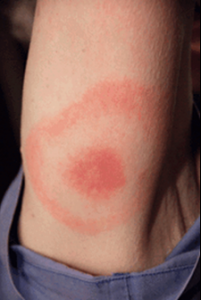Lyme disease is a bacterial infection transmitted to humans by a bite from an infected blacklegged tick. In Nova Scotia, only the blacklegged tick carries the bacteria that causes Lyme disease, and not all blacklegged ticks carry the bacteria.

What should you do if you think you have Lyme disease?
Tick bites are often painless, and you may not know that you have been bitten. Symptoms for Lyme disease typically appear 3 to 30 days after you have been bitten and may include any of the following:
- Rash (sometimes shaped like a bull’s eye)
- Fever
- Chills
- Headache
- Fatigue
- Aching muscles and joints
- Swollen lymph nodes
More severe symptoms (experienced weeks to months after a tick bite and no antibiotic treatment taken) may include but are not limited to:
- Severe headaches
- New skin rashes
- Facial paralysis (such as Bell’s palsy)
- Irregular heart beat
- Joint pain
- Nervous system disorders (such as dizziness, confusion or inability to think clearly, and memory loss, nerve pain, numbness or tingling in the hands or feet)
If you have recently been in a grassy or wooded area and have symptoms suggestive of Lyme disease, especially if they include a bull’s eye rash, you should seek prompt medical attention.
Reference: https://novascotia.ca/dhw/CDPC/lyme.asp



